Intro to the Seven Act Story Structure
I've built a customized archetypal story structure inspired by Joseph Campbell, KM Weiland, and Save the Cat
Background on the 7-Act Structure
I started writing seriously back in 2019. I had just gone through a painful separation that was a long time coming and was just in shock and recovering. I started playing Elite Dangerous, an epic space sim with a 1:1 simulation of the Milky Way galaxy. Yes, you can visit 200 billion star systems in that game. I was an explorer, and just lost myself in the game. I found a guild, an online clan of fellow players called a “squadron” and one thing I discovered is that there’s a huge meta-gaming community for Elite Dangerous. Some people roleplay various factions and elites, almost like a D&D but in space. So, I started writing flash fiction for our squadron, little fictional retellings of our missions, the planets our squadron defended, and the goings on in the broader universe.
My squadron leader, a fellow technology guy, loved my writing. He encouraged me to keep going and so I said hell with it, and began writing a novel. Fast forward a few months, I’d joined a local sci-fi writing group, where I met my current wife, and since immersed myself in the art of novel writing.
I did what most serious new authors do: I looked for YouTube videos and podcasts. I found Jenna Moreci, iWriterly, Terrible Writing Advice, and a few others. On the podcast front, I settled onto KM Weiland and Writing Excuses. After a while, you realize that videos and podcasts are low density and repetitive, so I branched out into reading about writing, starting with Hero with a Thousand Faces by Joseph Campbell, which the creators of the MCU refer to as “the big book.” If you watch any of the special features, Kevin Feige and others often refer to some mysterious tome from which their magic comes. It’s Joseph Campbell.
My wife has also introduced me to all kinds of structures, from the Shakespearean four or five act structure, Save the Cat, and so on. Basically, these are all frameworks that you can use to build stories. If you’re reading this, I’m assuming that you’re at least tangentially aware of all this, otherwise you’re probably going to be rather lost.
Over time, and through dozens of drafts of several novels, I’ve refined my own process. All successful authors end up with their own process. There’s no task quite so monumental, confusing, and overwhelming as writing a novel, and everyone will find their own patterns, habits, and intuitions. Heck, even from one novel to the next, your methods and intuitions will change. I’m constantly evolving, as should you.
Right now, my current approach is the Seven Act Structure, as depicted below.
It’s pretty straight forward.
Each act is roughly the same length. One thing I didn’t like about other structures is that they use percentages or lopsided acts. For instance, in the typical two act structure, act two is the majority of the story. From a systems thinking perspective, this is just a bad framework! It’s a lot like the “draw the rest of the owl” meme:
Any good framework should be structured as a somewhat consistent and pragmatic taxonomy. The Campbellian Hero’s Journey is a bit more visually appealing than some others, but it’s also overly constrained, and pretty much only applies to one kind of archetypal character arc, but I needed a framework that would apply to all or at least most stories, particularly those with multiple POV characters. As I write epic space opera, with four or five characters, there’s a lot more to keep track of.

So, after listening to KM Weiland and Writing Excuses (the podcast that Brandon Sanderson is on, btw) for the last 5+ years, plus reading a handful of books recommended by this crowd, I’ve arrived at my own plotting and outlining structure.
The Seven Act Story Structure Overview
So, before we dive into each act in detail, it would probably be good to give you a high level overview, other than a simple pie chart.
Without further ado:
Stasis: Introduce the reader to the world, characters, some of the history, and hint at the flaws of the character, the plot, and so on.
Rubicon: This is the transition from the Ordinary World to the Special World. You might know this as the Call to Adventure, the Threshold Guardian, and a few other archetypal plot beats. I sum all this up as “crossing the Rubicon.”
Unraveling: This is where the MC’s (main character) worldview starts to come undone. Their Ordinary World approach starts to fail in the Special World, but also, outside of the protagonist, the world itself might start to come undone (the Empire makes itself known, etc)
Midpoint: This is the archetypal Moment of Truth, the main turning point of the story where the protagonist(s) switch from reactive to proactive, when all the cards are laid on the table, and the villain/nemesis/enemy is fully revealed.
Escalation: This is where the characters face setbacks, the stakes increase, and everything accelerates towards the climax. You might know these beats as the Darkest Hour, the Innermost Cave, the Belly of the Whale, and The Reversal.
Climax: These are the chapters where everything comes to a head. In the MCU, this is the “Avengers Assemble” moment, where everyone gets together for planning the final mission. They lay out all the stakes, the plan, and then everyone sets out on the Final Mission.
Denouement: This is the “unknotting” or the letdown as everything descends into the New Normal, or a new stasis or equilibrium is established. In the Campbellian cycle, it’s a literal return home, but this does not always work. It can be a return, but sometimes to an inexorably changed world.
As mentioned previously, each of these sections can be more or less the same length, which really helps me as a systems thinker. The conventional three act structure really does not translate, especially to screen. I just watched Furiosa and the Ordinary World is all of about 5 minutes at the beginning of a 2.5 hour movie. Talk about a lopsided framework! However, having been working on articulating this seven-act structure, I was able to recognize each transition. Here’s an example breakdown:
(SPOILERS)
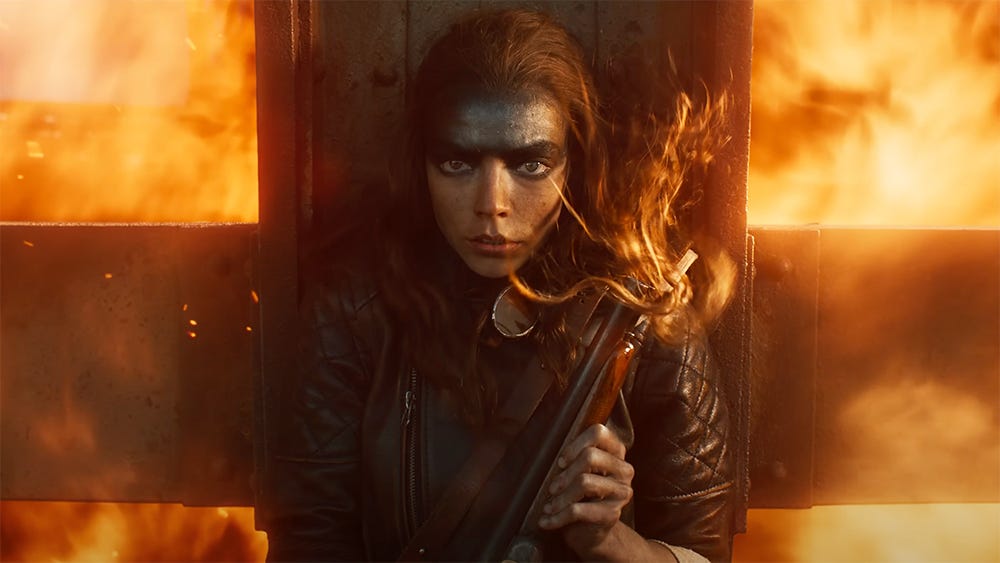
Furiosa: Stasis
The movie opens with a young Furiosa in a lush valley, an oasis in the desert. She’s harvesting tree fruit with her sister. This does a great job of showing us her Ordinary World - a child of the abundant Green Place.
Furiosa: Rubicon
The Rubicon moment is forced on her very quickly with an attack from Chris Hemsworth’s desert raiders. She’s abducted and her mother comes after her. In this case, she’s thrust into the special world.
Furiosa: Unraveling
A young Furiosa is forced to watch her mother tortured to death, over a burning fire (sort of burned like a witch?) and then this is repeated as she’s brought like a pet on the warlord’s many adventures. We see that everything she knows about the world is wrong, and so she becomes hardened and cold.
Furiosa: Midpoint
The midpoint comes when we see the butte with Immortan Joe and she’s put in with the wives, and finally escapes. She has now stopped reacting to the special world and takes full ownership of her fate. But also, at this point, we’ve met all the characters. We know that Chris Hemsworth is the real villain, and we’ve also met her primary ally, Praetorian Joe.
Furiosa: Escalation
Now that Furiosa is taking ownership of her fate, she goes on missions with Joe, and sees the world through a more adult lens, learning how to go on the attack (literally, and emotionally). Her cutting off her arm, I think, represents the transition towards the Climax.
Furiosa: Climax
Predictably, the climax is a battle with Chris Hemsworth’s character, which culminates in an incredibly emotional confrontation where he says he’s “right there with her” and that he’s suffered the same as her: his family killed, and that no amount of torturing him will do anything to bring them back. It’s all very grimdark, but that’s the point of Mad Max.
Furiosa: Denouement
The story ends with a fully empowered and victorious Furiosa being watched by the narrator, talking about the fate of Chris Hemsworth and then we have a final cut of her shepherding the wives out onto the war rig, creating a perfect transition to Fury Road.
Using this Structure
This movie was almost exactly 2.5 hours, or 150 minutes. If you divide that by 7, you get 21.5 minutes per act, which is more or less how much each has. As with a lot of screen, the first and last act are shortest, about 5 to 10 minutes. This is time that can be donated to other acts.
Most novels are between 20 and 50 chapters, so again, you can divide up pretty evenly, say about 3 chapters on average for a shorter novel, or up to 10 chapters each for a longer novel. Or, my favorite novel of all time, Kushiel’s Dart, a whopping 96 chapters breaks down to an incredible 13 to 14 chapters per act on average. And, considering how much time you spend with young Phaedra learning the ropes of the Night Court and her life as a virginal courstesan, well, yeah it makes sense.
Now, with all that being said, let’s take a closer look at each act and unpack what needs to happen in each.
Act 1: The Ordinary World (Stasis)
We see Luke fixing stuff on the moisture farm, Frodo reading against tree, and Bilbo smoking his pipe. This is the ordinary world. The status quo. The stasis. All the best stories make it a point of showing the Normal World before everything changes. Even ATLA starts by showing Katara and Sokka on a fishing trip before they find Aang, and then the go penguin sledding.
This is where you do all the basics: introduce the audience to the characters, the setting, and so on. There are a few things that you really ought to do here:
Introduce the protagonist: Obviously, you need to show us the MC, but you can also hint at their Theory of Control. This concept was introduced to me by Will Storr in his book The Science of Storytelling. He pointed out that all humans have a theory of control, which is how they approach the world. The theory of control is based on their personality, flaws, history, trauma, correct and incorrect beliefs. The theory of control is a really great concept because it packages up SO MUCH about a character, and also is the core of their growth arc: their theory of control must be challenged. More on all this later.
Introduce the rules of the world: How does this world work? Magic, technology, social rules, laws, etc. The opening of Star Wars shows us space ships, space battles, droids, and Darth Vader force choking someone. By couching all this within the narrative, by just showing the audience a day in the life of the MC, we get to see what they expect, how they engage with the world, and so on.
Hint at the inciting incident: The inciting incident (II) often happens long before the story actually begins. In Star Wars, it all started decades earlier with the rise of Palpatine and the fall of Anakin. In Lord of the Rings, it started eons ago with Morgoth and Sauron. Peter Jackson pulls off an info-dump prologue really well with Lord of the Rings. In Star Wars, George Lucas just slaps you in the face with a futuristic robo-samurai dude (Vader). For Frodo, Gandalf shows up and Bilbo leaves his Ring.
These are three primary things that really must happen in the Stasis act. You can also weave in some of the following:
The Call to Adventure: This is where someone or something shows up or happens that beckons. In The Hobbit, it was Gandalf and the dwarves showing up, literally inviting Bilbo on an adventure. This was followed by his Refusal and Debate. However, I often don’t like this because many stories don’t actually give the MC a choice. For Luke, for instance, his family was killed. What was he going to do? Stay at the homestead? That’s not really an option. In Dante’s Peak, a freaking mountain erupts. Sure, you could always have the characters choose a quiet life. Go away from the mountain, stay on Tatooine, etc. But it’s really only the truly mythic stories where it must be a choice to engage in the Special World. Another example I like is Independence Day with Will Smith. The Call to Adventure is… gigantic alien ships show up. As a captain in the USAF, our MC does not really have a choice but to fight. So again, you can see why I’m often skeptical of the Call to Adventure or at least the Debate/Refusal portion. Not that these are bad plot beats, my only criticism is that they are not universal.

Here’s a quick recap of, generally speaking, what must be in Act 1:
Introduce the Ordinary World: Show us how the world works, its rules, culture, customs, norms. This is the “a day in the life” of the MC before everything goes haywire. Show us Luke on the moisture farm or Frodo reading in the Shire.
Introduce the Characters: In The Hobbit we meet the central cast all before crossing the Rubicon, but this isn’t always the case. You generally have more characters showing up as the story progresses. Even video games often honor this, with games like Mass Effect and Dragon Age having an early section of the game of “building the team” where you go and recruit everyone.
Hint at the Inciting Incident: Generally speaking, you don’t reveal the main conflict right up front. In Lord of the Rings we don’t really know what the conflict is until the One Ring is revealed (the opening voiceover being excepted here). But, just the appearance of Gandalf hints as the call to adventure.
Keep in mind that it is totally optional to even show the main conflict or villain in the Stasis act. From Kushiel’s Dart to Fellowship of the Ring, we spend a TON of time in the ordinary world with low stakes. I actually struggled with Wheel of Time (I know, I’m an apostate for saying this) because it dives straight into a troll attack without giving me sufficient worldbuilding or time with the characters. But I digress, I know I’m weird for loving Kushiel’s Dart and it’s mammoth Stasis act.
Act 2: Crossing the Rubicon
In both Fellowship of the Ring and The Hobbit, we have a pretty long time crossing the Rubicon. Rather than thinking of it as a singular moment, such as when Samwise declares “if I take one more step, it’s the farthest from home I’ve ever been.” it’s really a process. A transition, or a liminal space.
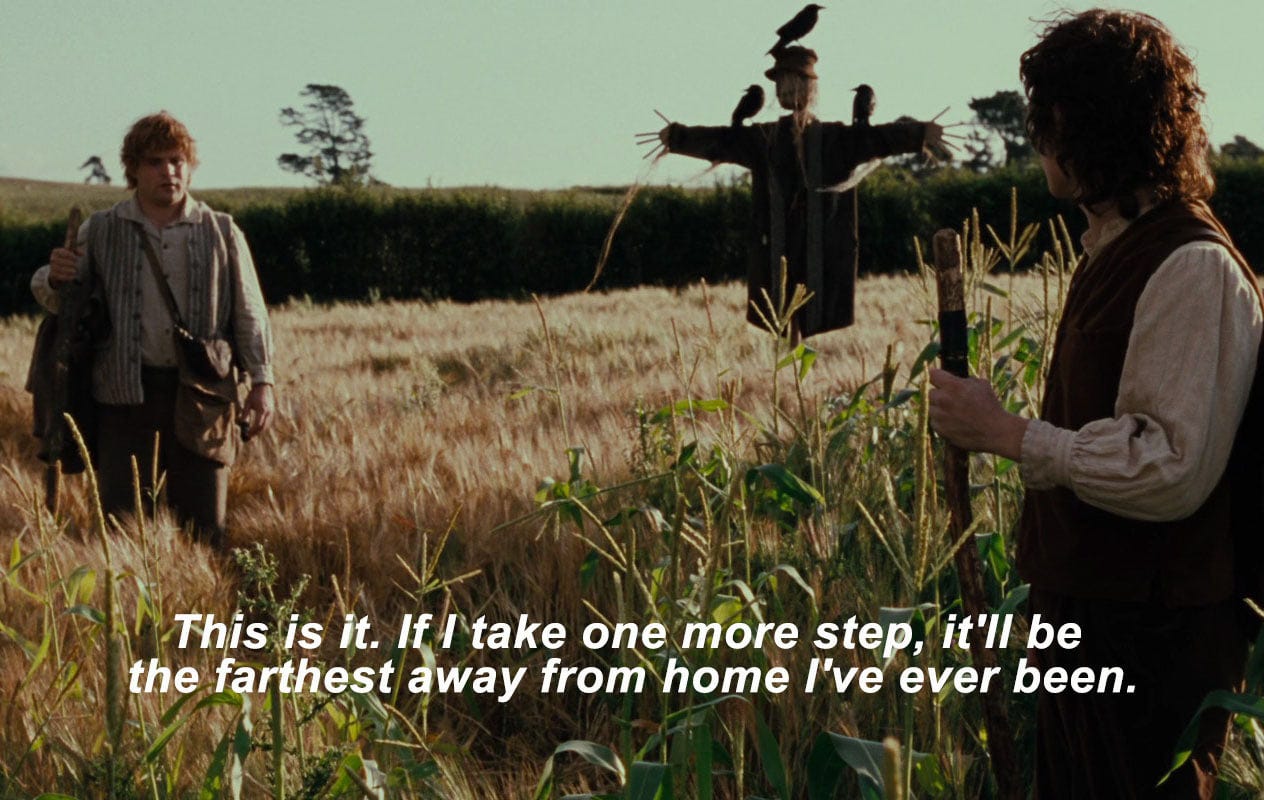
Sam, in this case, says the quiet part out loud. Everything he knows, as he is highly cognizant of, is slipping away. By transitioning into the new world, he is declaring that they are indeed crossing the Rubicon. Immediately after this, they bump into Merry and Pippin, a reminder that they are not too far outside of the ordinary world.
Except…
They have a first encounter with the Nazgul! This is a key moment because this is really their first encounter with the Enemy, or the supernatural. The Black Rider sniffing around is the first sign that something really is amiss, and they aren’t in Kansas anymore.
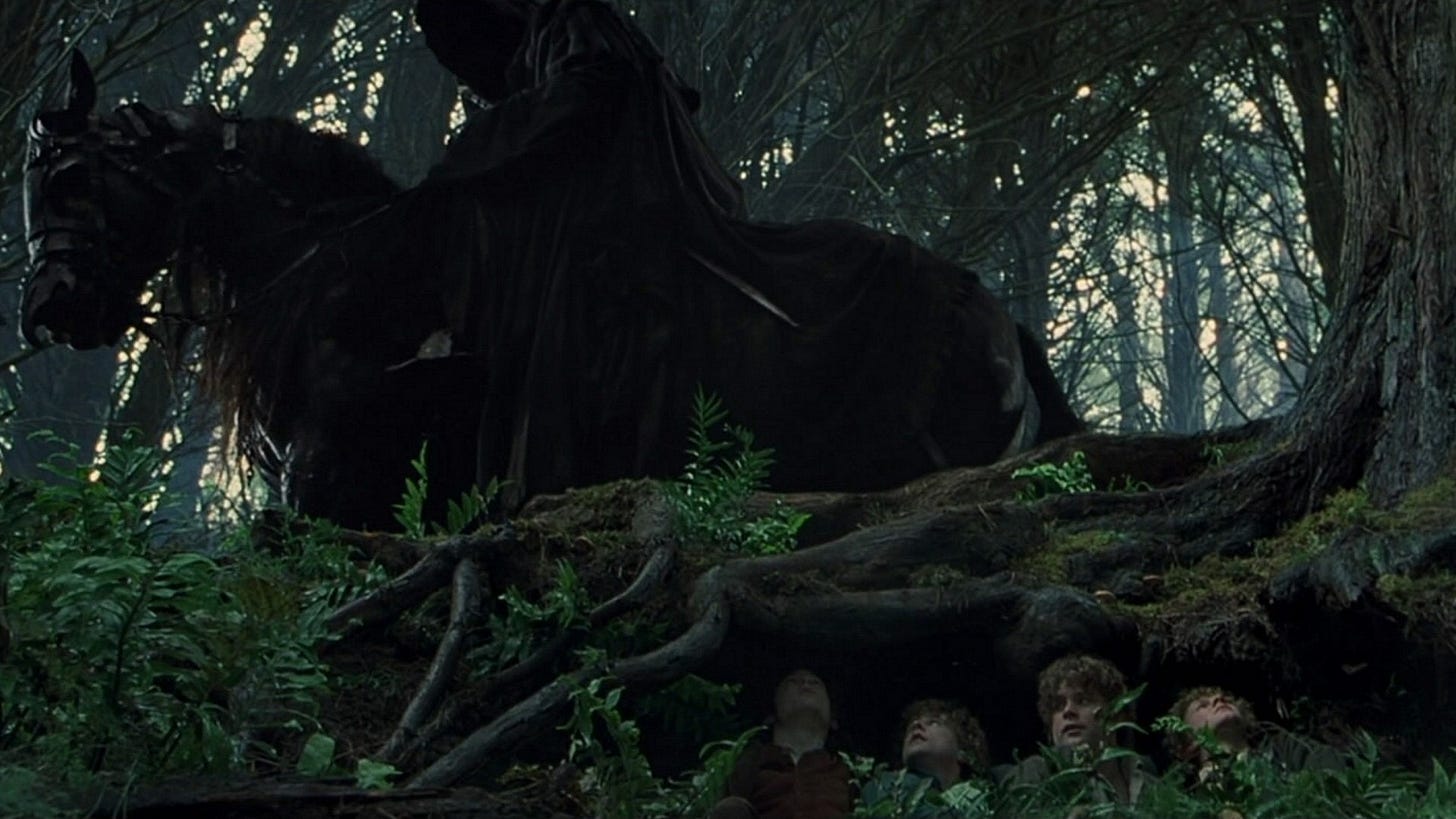
This continues with the race to Buckleberry Ferry and their trip to Bree to meet Gandalf at the Prancing Pony, and their encounter with Strider aka Aragorn. Personally, I think that the Rubicon act ends with the jump onto the barge. They are well and truly leaving home and the Shire. But think about it this way: the Rubicon scenes start with Sam’s declaration about being far from home, and then end with their approach to Bree.
Act 3: The Unraveling
This is where the MC’s worldview starts really failing, not just being challenged. Not only that, but the world around them starts to feel more hostile, chaotic, and unpredictable. We see this twice, in relatively rapid succession during Act 3 in Fellowship. First, with Frodo accidentally donning the Ring and then the Nazgul stabbing their dummies in bed, followed by the attack at Weathertop.
Here, we see that the Hobbits’ way of dealing with the world fully falls apart: Samwise puts up his dukes ready to take on Strider, which obviously fails immediately, and then they only survive the Nazgul attack because this mysterious stranger teaches them a new way to deal with this threat: deception.
Then, again, we see the Hobbit methodology fail utterly when Merry and Pippin are cooking dinner on an open fire, which attracts the Nazgul again. So here we see their worldview constantly being challenged, and in this case, with dire consequences. This leads up to what KM Weiland calls the first pinch point. In this case, Frodo getting stabbed by a Morgul blade.
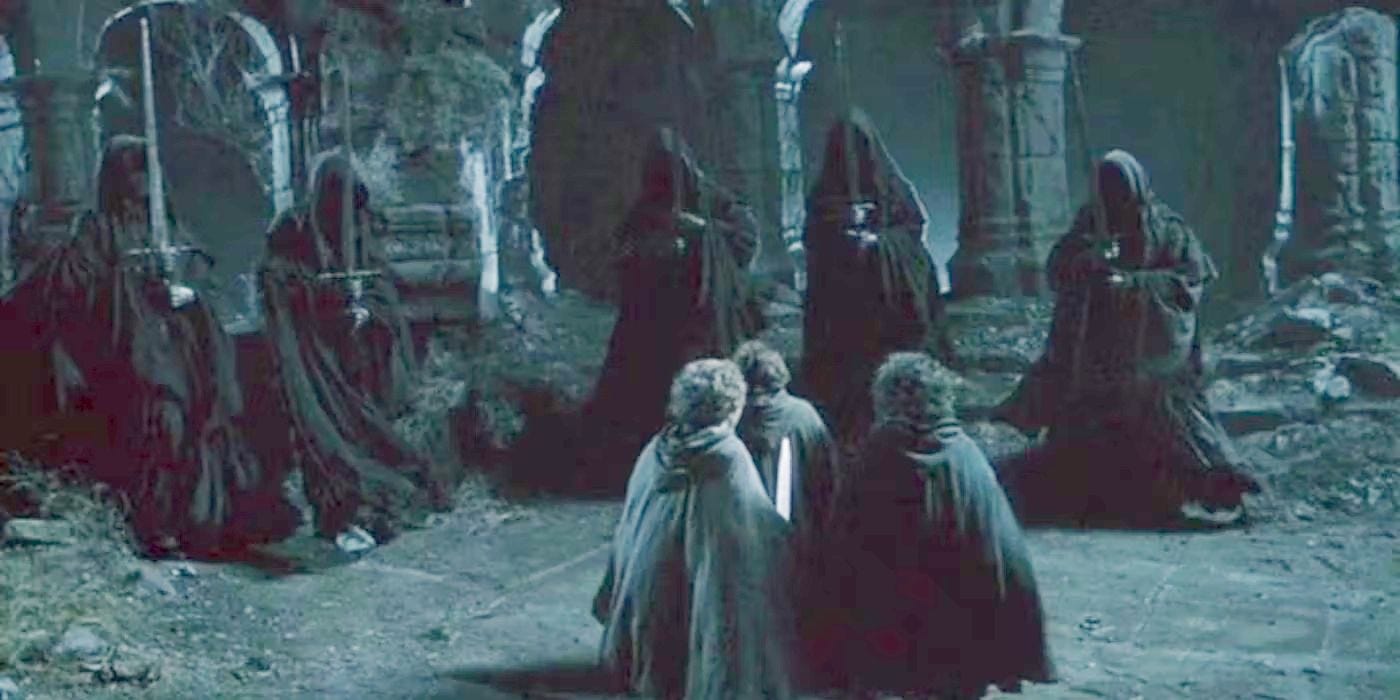
The First Pinch Point
This is a critical plot beat where the enemy asserts their presence and the audience is reminded that the threat is real. The Nazgul, agents of the Arch Nemesis, act as surrogates, reminding us that Sauron the Deceiver is alive and well, and his agents of destruction are a very real threat. Merry and Pippin’s foolishness, a last attempt to assert their old worldview, that tomatoes and bacon for dinner is a good idea, fails and costs their friend dearly.
In this case, the Unraveling act forces all the protagonists to kick it into high gear. Fortunately for them, Arwen shows up with her elven-bred horse and magic to carry Frodo to safety.

Act 4: The Midpoint
The middle of Fellowship is a huge breath for the audience. We get some peace and respite. Frodo and friends get to hang out in a peaceful Elven resort for a bit, protected on all sides by ancient Elven warriors, steep cliffs, and hidden magics. Not only that, we get a reunion with Bilbo.
Here is where the Council of Elrond takes place, where everyone else joins up - the rest of the crew, and all the cards are laid out.
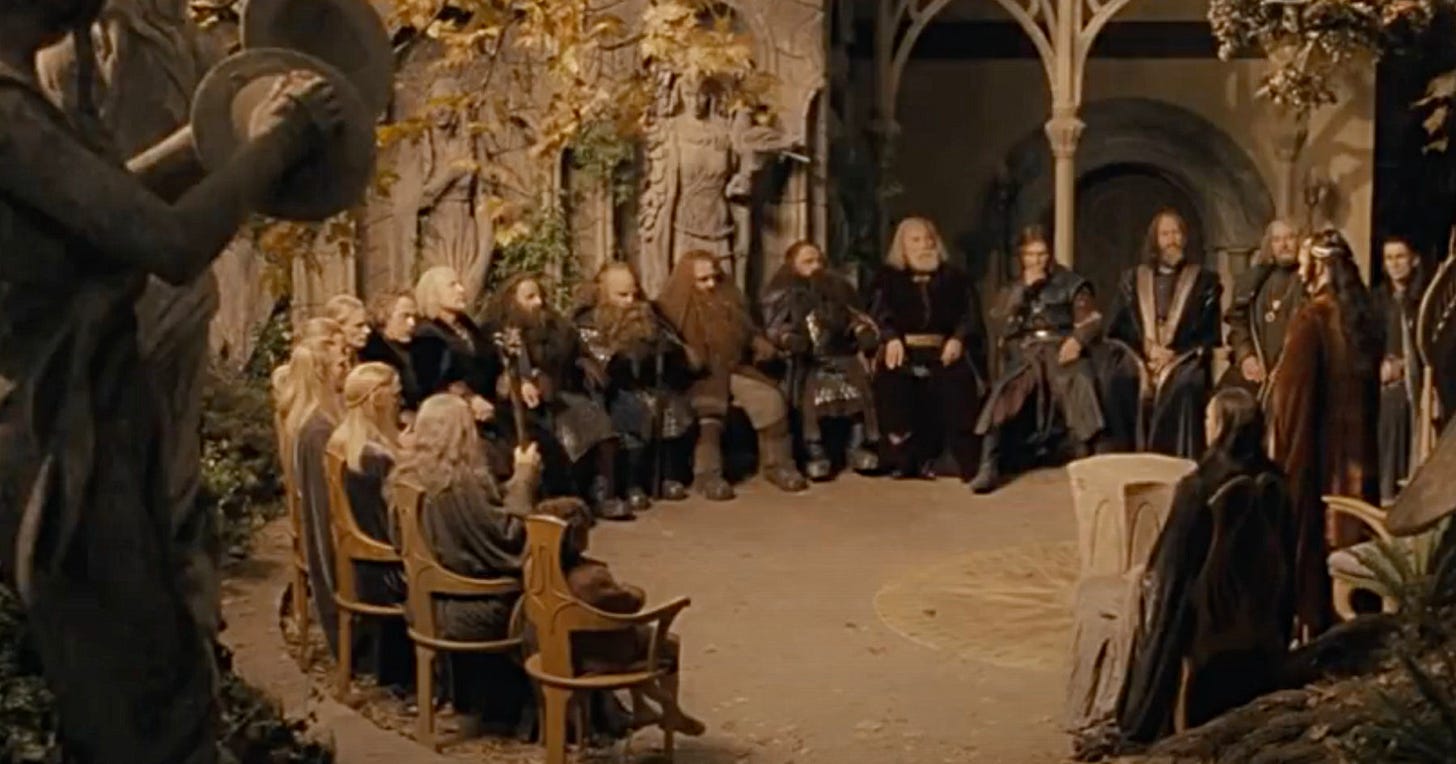
In the case of the Fellowship, the Midpoint is very clearly their time at Elrond’s shack on the river. Many stories are not so clear cut, but some are. The key thing that happens here is the All is Revealed moment, hence the Moment of Truth.
From a mythic perspective, this is also an opportunity for the heroes to go home. As Sam says: we’ve done our part, and this is too big for us. Part of the Campbellian mythic cycle is that the hero must choose the adventure every step of the way. If they are forced, it’s not quite as mythic (not that it’s a bad story). But as Sam says at the end of the films: what really makes the stories great is that they never gave up, even when they could have gone home, even when all hope was lost. They chose to stay the course.
The Moment of Truth
Above all else, the key scene of a Midpoint act is the Moment of Truth, when all is revealed. This is what makes the midpoint a key turning point. The stakes become clearer, and sometimes they are totally unexpected. In some cases, it’s a Grand Revelation, such as the realization that you’ve had a traitor in your midst, or that the earth quakes are not just seismic in nature, but the planet is coming apart! Suffice to say, by the time you finish with the Midpoint act, your characters must be fully informed of what’s going on, what the stakes are, and who the enemy really is. The obvious exception are things like murder mysteries. In thrillers, such as Death on the Nile, the Moment of Truth is when the Prime Suspect turns up dead or something along those lines.
Act 5: Escalation
In Fellowship the Escalation is rather protracted, with their attempt to go over Caradhras (the mountains where Gandalf and Sauron have a wizard yodeling match) and then they decide to go through the Mines of Moria instead, culminating in their battle with the goblin and the fight with the Balrog.
In this case, the major Reversal and Innermost Cave happen at the same time. The Death of the Mentor is an archetypal story beat, which in my opinion, represents the premature death of our grandparents - legendary figures of wisdom and stability in our lives. So Gandalf falls to the Balrog during the mine traversal, once again reminding us that the stakes are very real in this new Special World.
Part of the Escalation act is indeed the Reversal, the Darkest Hour, or the Innermost Cave. Arguably, the Darkest Hour or All Is Lost moment of Fellowship is the uruk attack on the banks of the Anduin and the breaking of the Fellowship. I often do not differentiate, though, because many stories compress all these into one single beat. But not always. Take the Avengers: Endgame for instance. We have an almost identical set of plot beats with the death of Nat (Black Widow), the team grieving, and then gearing up for the final battle. Likewise, we have some grief for Gandalf, with the epic elfsong Lament for Gandalf.
But I digress, most stories that honor the truth mythic cycle put the Darkest Hour in the Climax act, but the Innermost Cave (e.g. turning inwards for grief, etc) in the Escalation act.
Here’s a recap of what’s really critical to include in the Escalation act:
Second Pinch Point: The audience must be reminded of what’s at stake. This is some kind of setback - perhaps the death of a party member, the loss of a ship, or something along those lines. Sometimes the enemy is on screen again, like how Darth Vader pops up from time to time to remind the audience that he’s the BBEG (Big Bad Evil Guy)
Reflection: This is the Belly of the Whale or the Innermost Cave - a period of time when the characters have realized there is no going back, and they must process the trauma of their journey so far. In Frodo’s case, it’s about processing the grief of losing Gandalf as well as looking in the reflecting pool of Galadriel to be reminded of what’s at stake.
Generally speaking, Act 5 ends once the team is ready for the final battle. This is the final assault on Endor, which might also have a reversal (e.g. Darkest Hour or All Is Lost moment). I call this plot beat the Avengers, Assemble! moment. When you look carefully, you even see this plot beat in romance movies like Eat, Pray, Love. After the protagonists toy with the idea of falling in love and retreat back to their ordinary worlds, they gather their strength by consulting with their friends and spiritual guides, and then take the final plunge into a new world of romance.
Act 6: The Climax
This is the final battle for all the cookies. As mentioned, the MCU makes this painfully obvious when Captain America or Tony Stark or Thor lays out everything that has happened, the team is all in the same room together, and they have a rallying pep talk that generally ends with go team!
Now, the Climax act is not one scene or one moment! There’s a lot that needs to happen.
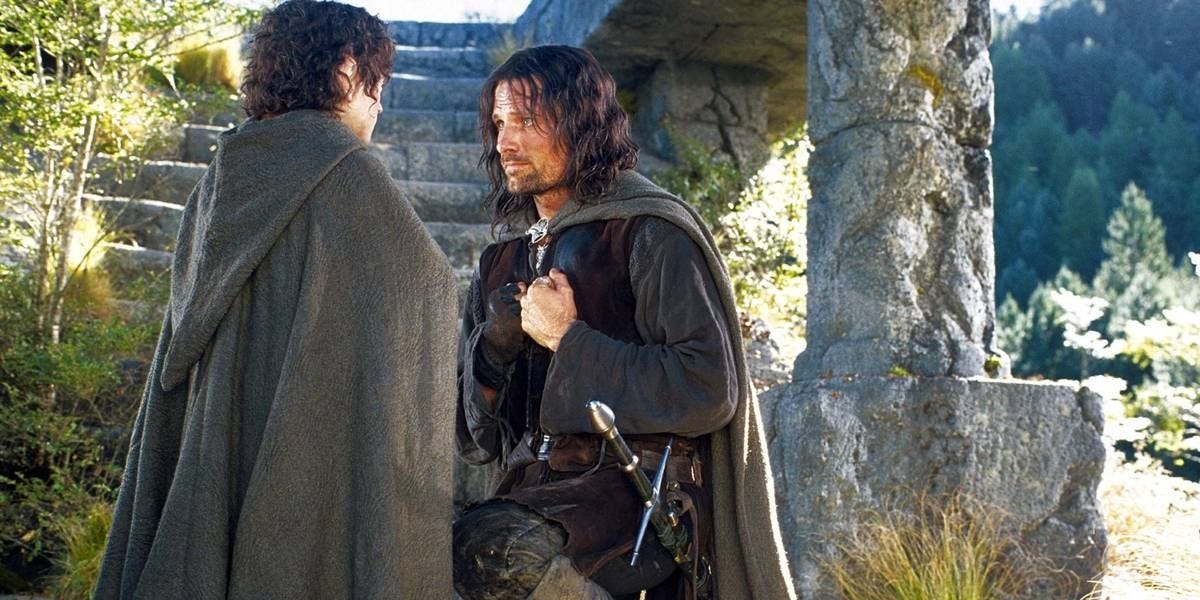
The Darkest Hour
Far and away, the most important beat to always include in the Climax is the Darkest Hour, or the All Is Lost moment. In Fellowship, this is when Boromir gets killed and the Hobbits get carried off. This when the audience is like “Well… shit.” Despair threatens to take over.
In Return of the Jedi this is the legendary “It’s a trap!” scene with Akbar, and also when the Rebels get surrounded, Leia gets shot, and Luke gets turned into a seared steak.

I don’t think there’s much more to say. The Climax has been well studied since the time of Ancient Athens, so I’m not really adding anything new here.
Act 7: Denouement
The denouement or the “new normal” is the letdown at the end of the story, where either your princess lives happily ever after or at least your characters return to a “new normal.” The new Status Quo is a period of relative stability and normalcy after the epic journey. In the case of long sagas, it’s a breath between major story arcs. In standalone sagas, it’s the hero returning to their normal life.
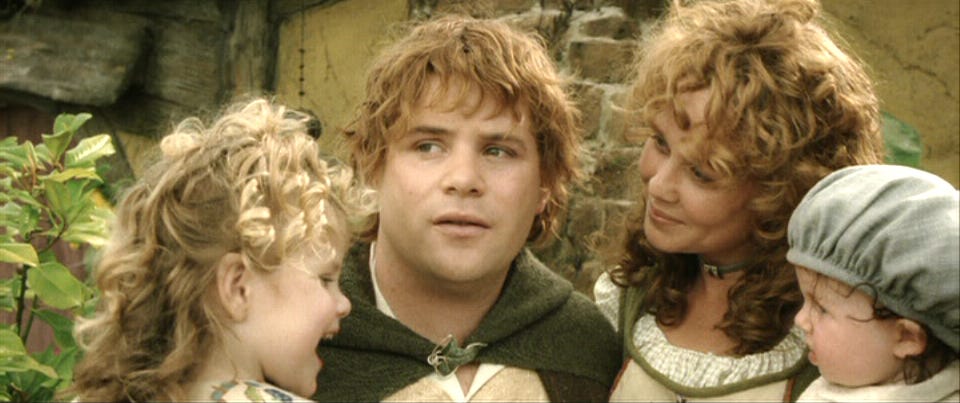
Movies tend to have a very short denouement lately, although some have taken to showing the “new normal” during the credits roll, where you see the characters settling into their post-adventure life. This is very typical in romance and comedies. I recently watched Long Shot with Charlize Theron and it handles this perfectly, showing her having won the presidency during the credits roll, which is a perfect and satisfying conclusion.
In Dragon Age: Inquisition, they do more or less the same thing, showing all your choices playing out on your party members during the credits. Depending on choices you made, some of them are happy, such as Cassandra moving to the mountains with your Inquisitor for a nice quiet life, or becoming Divine. You also get some shenanigans with Sera if you befriended her. Most hilariously, you get Cassandra reading some of Varric’s writing. Again, having a long denouement is more typical of more mythic stories, where you’ll be left a bit more raw and wanting to see how the world proceeds.
Below is the credits roll from DA:I Trespasser, one of the best ways of letting the player down after spending a couple hundred hours in this amazing world.
Also, I will never forgive Bioware for making us wait a fucking decade for another DA game. Talk about shooting the goose who laid the golden egg…
References
Below are the primary sources of inspiration for my Seven Act Story Structure. I more or less stumbled into this structure because of my first epic space opera, with a large cast of characters. I ended up giving each character 7 or 8 chapters in the early draft, and so, with only a handful of chapters for each character, I grouped them together in more or less the same acts as each other, cycling through.




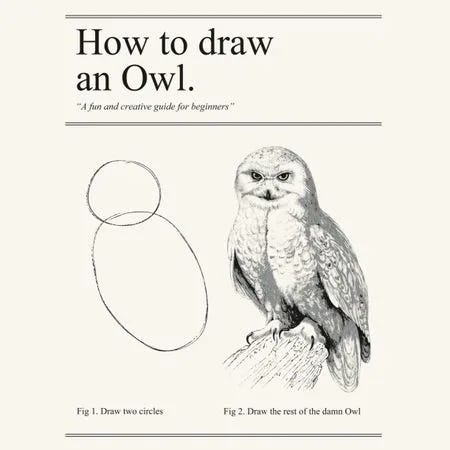
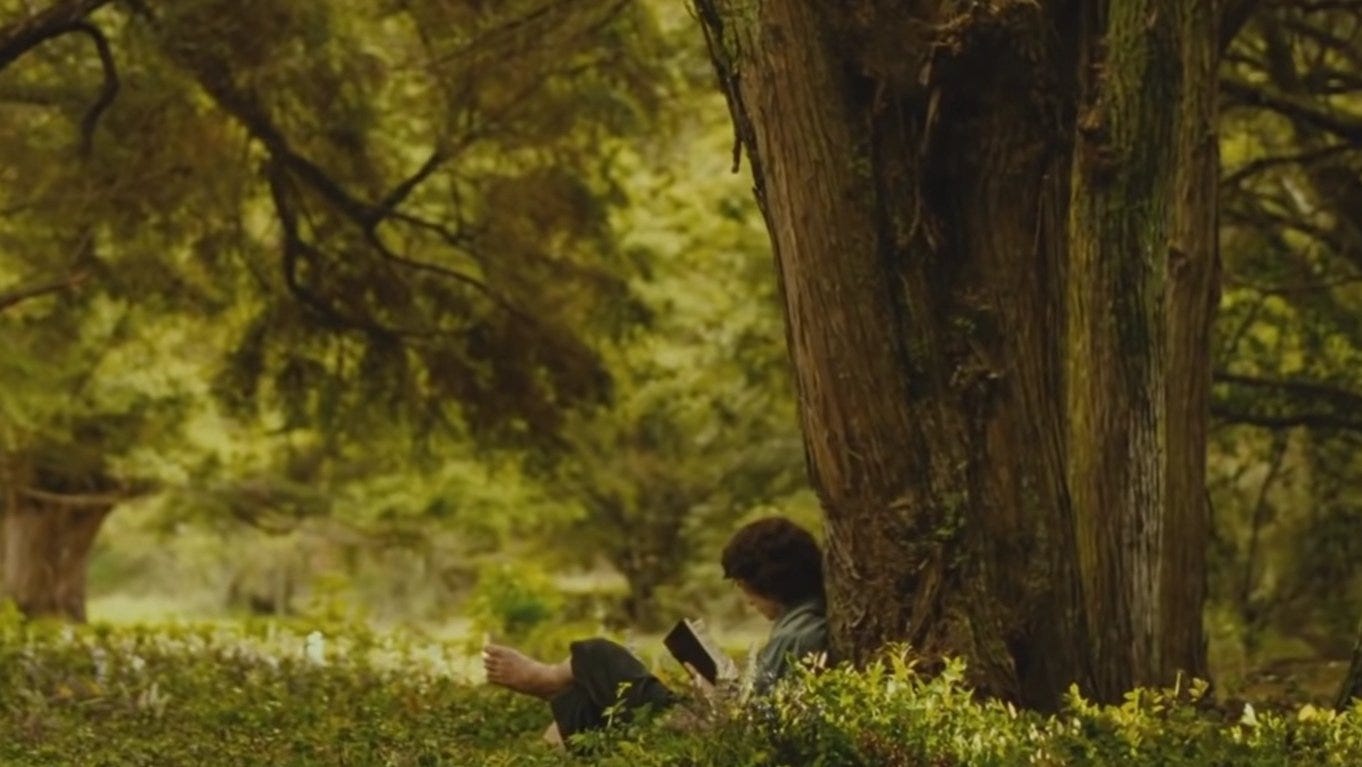
Now that read was a great gift on my birthday!
Thank you!